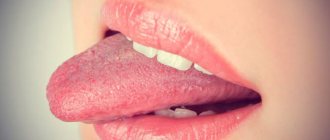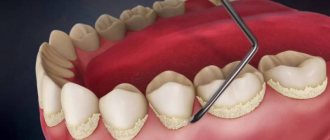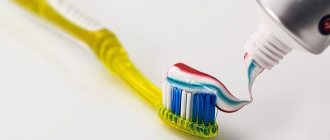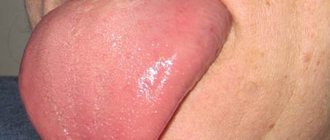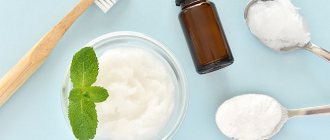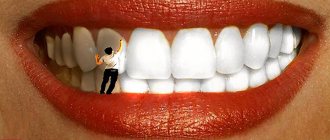White coating on the tongue is usually perceived as a symptom of the disease. A person, as a rule, does not consider his language. In order for us to stand in front of the mirror, stick out our tongue and begin to look at it, there must be some reason that prompted us to do so - discomfort in the throat or oral cavity or some other dissatisfaction with our health. And then we discover a white coating on the tongue (or, as they sometimes say, that our tongue is coated ). However, don't be scared right away. Even a healthy person can have a white coating on the tongue. On the other hand, plaque on the tongue can indeed be a manifestation of the disease. Therefore, it is useful to know how pathological plaque on the tongue differs from plaque, which is considered a variant of the physiological norm.
Physiological white coating on the tongue
White coating on the tongue is most often found in the morning. At night, less saliva is produced, which contributes to the activation of bacterial activity. As a result, by morning, almost all people develop a white coating on their tongue. Sometimes it is accompanied by bad breath.
As a rule, such plaque is easily removed during morning oral hygiene. When we brush our teeth, it is advisable to also brush our tongue, especially its root. Modern toothbrushes have a surface specially modified for this purpose (the other side in relation to the bristles).
However, the white coating disappears on its own as the day begins. It is erased when eating, and the greater amount of saliva released prevents it from forming again.
How to remove plaque from the tongue at home
How and with what to clean the tongue of an adult? There are several ways to quickly deal with this problem. Let's look at each of them in more detail.
Scrapers
These are special loop-shaped devices made of hygienic plastic. Scrapers effectively remove plaque without causing discomfort or gag reflexes. The tool must be moved from the base of the tongue to the tip until the film disappears. After this, the mouth can be rinsed with an antibacterial solution.
Toothbrushes
Most models have special pads on the back surface or removable attachments for removing plaque. Hygienic procedures are carried out according to the scheme discussed above. To enhance the effect, you can apply a small amount of toothpaste to the surface of the nozzle.
Irrigators
These are modern devices for comprehensive oral care. The essence of the irrigator’s work is the directed supply of a stream of water, which gently but effectively removes food debris and plaque on tooth enamel and tongue. Irrigators work very delicately, the possibility of damage to the mucous membrane is completely eliminated. In this case, to enhance the effect, water can be replaced with a medicinal liquid with an antibacterial or anti-inflammatory effect.
Spoons
Sold in pharmacies, in appearance they resemble a small spatula with rounded edges. Thanks to this form, the possibility of injuring the tongue is eliminated.
Special spoon attachments are available for irrigators. For example, a replaceable nozzle TS-100E. This instrument is recommended by dentists for daily hygiene procedures; it effectively removes plaque and helps freshen breath.
Rinse
To clean the tongue, decoctions based on medicinal herbs and plants are used:
- Oak bark;
- Propolis;
- Calendula;
- Sage.
However, it is important to understand that it will not be possible to remove plaque with the help of decoctions alone. This method cannot replace mechanical cleaning and is used rather for preventive purposes.
Pathological plaque on the tongue
If the white coating on the tongue is caused by an illness, it persists throughout the day. A thin white coating occurs with any ARVI. It disappears as soon as the patient recovers.
Particular attention should be paid to the compaction of plaque. The body of the tongue is not visible through the thick coating. Such plaque is difficult to remove. Thick plaque is considered a sign indicating the severity of the disease.
The color of the coating on the tongue is also important. The more intense the color, the more serious the pathology that caused the plaque. The color of plaque is not only white. A yellowish tint to the plaque may be associated with a malfunction of the gallbladder or pancreas. Gray plaque is possible in case of stomach disease - gastritis, peptic ulcer. In some severe infectious diseases, plaque may acquire a black, bluish or greenish tint.
However, it should be taken into account that the color of plaque can be affected by smoking, drinking and eating.
What can cause pathological plaque?
The main reason is a malfunction of the internal organs. However, there are two other possibilities: smoking and improper oral hygiene. For active smokers, a yellowish coating is a constant companion, which may not indicate anything bad about health other than the presence of a bad habit. If you don't brush your mouth properly, your tongue will be completely ignored. It is wrong to brush your teeth alone. Bacteria accumulate on the surface of the tongue; they also need to be removed. To clean the tongue, many toothbrush manufacturers make a special brush on the other side. There are also scrapers for the surface of the tongue.
If a person does not smoke and maintains proper hygiene, but there is still plaque, then this may be an indicator of the following diseases:
- Diseases of the digestive system (the most common cause) are ulcers, gastritis, diseases of the gallbladder, pancreas, and liver. Usually in such cases the plaque is accompanied by a persistent unpleasant odor that does not go away even after cleaning.
- Diseases of the respiratory system - tuberculosis, bronchitis, asthma.
- Infectious diseases - influenza, sore throat, ARVI, acute respiratory infections.
- Reduced immunity.
- Diseases of teeth and gums.
- Changes in acid-base balance due to medications.
Diseases that cause plaque on the tongue:
- stomatitis;
- thrush (candidiasis). Caused by fungi of the genus Candida. The disease can be caused by long-term use of antibiotics or decreased immunity. With oral candidiasis, a typical manifestation is a dense milky-white coating that covers the tongue in spots. Similar spots may also appear on the roof of the mouth or gums. In severe cases, plaque covers the entire tongue as well as the walls of the throat, making swallowing and breathing difficult.
- scarlet fever. In the first days of the disease, the tongue is covered with a white-gray coating. Then the coating disappears, and the tongue acquires a crimson color;
- whooping cough. A pale yellowish coating on the tongue may be accompanied by bad breath;
- dysentery. A thick white coating is typical;
- cholera. Characterized by a dark coating (even black);
- diphtheria;
- gastritis;
- stomach ulcer;
- enterocolitis;
- pancreatitis;
- stomach cancer;
- kidney diseases;
- some other diseases.
How to properly clean your tongue with an irrigator
Cleaning the tongue from plaque with an irrigator is carried out in compliance with the following rules:
- The procedure begins with a slight pressure, which gradually intensifies;
- The angle of impact of the jet should vary between 60-90 degrees;
- Duration of cleaning – 2-3 minutes;
- First, the general surface of the tongue is processed, then hard-to-reach areas;
- The procedure must be performed daily, at least once.
It is important to understand that the use of irrigators does not mean giving up mechanical brushing of teeth. Therapeutic liquids for the device are used strictly as prescribed by the doctor.
When and which doctor to contact about a coating on the tongue
As a rule, tongue coating is not the main symptom.
And it is other symptoms that tell you which doctor you should see. If plaque on the tongue is accompanied by symptoms of ARVI, you should consult a physician. If you have symptoms of gastrointestinal diseases, contact a gastroenterologist. If there are no such symptoms, and the cause of your concern is plaque, in case of white plaque you can consult a dentist, in case of yellowish or gray plaque, you can consult a gastroenterologist. And in any case, you can consult a general practitioner - family doctor or therapist. A child with a persistent coating on the tongue should be shown to a pediatrician.
How to properly clean your tongue with a toothbrush
How to properly clean plaque from your tongue using a toothbrush? To do this, it is enough to follow the following rules:
- Cleaning is performed after basic hygiene procedures: brushing the teeth and rinsing the mouth;
- Plaque is removed with progressive movements: the brush goes in one direction, first from the root to the tip of the tongue;
- Then the brush moves in the transverse direction, and then in the return direction: from tip to root;
- 4-6 movements are made in each direction;
- After this, the inner surface of the cheeks is carefully processed,
- At the final stage, rinse with an antibacterial solution.
Possible reasons
Possible causes of the appearance of white plaque in combination with a sore throat include the following factors:
Minor injuries and any other damage to the tongue
For example, a person accidentally cuts his tongue with a fork or toothpick, and pathogenic bacteria penetrate through the damaged tissue, causing inflammation.
Long-term use of any medications
If a person has been taking antibiotics, steroids or other drugs for a long time , such symptoms may appear.
Hormonal disorders in the body
In women, this can happen during menopause.
Associated symptoms in this case: burning and dry mouth, increased sweating.
Gastrointestinal pathologies
Stay up to date! This can be gastritis with low or high acidity, stomach and duodenal ulcers, colitis or enterocolitis, etc.
Diseases of the digestive tract are usually accompanied by symptoms such as abdominal pain, nausea, constipation or diarrhea, and heartburn.
Inflammation of the gallbladder
Associated symptoms: pain in the lower abdomen (on the right side), dry mouth, high fever.
Infectious diseases
Among them are dysentery, scarlet fever, diphtheria, immunodeficiency virus and others.
Infections, as a rule, are not limited to just plaque and sore throat.
- White plaque on tonsils in adults: causes, methods of treatment
Usually accompanied by the following symptoms: body temperature above 38-39 degrees, muscle pain and aches, skin rash, diarrhea, vomiting.
Diseases of the throat and oral cavity
Keep in mind! As a rule, tonsillitis, tonsillitis, pharyngitis, stomatitis are characterized by such symptoms.
This may increase body temperature (in some cases) and cause weakness in the body . There may also be problems with swallowing food, burning and dry mouth, hoarseness in the voice, etc.
Viral infections
This is the flu, ARVI .
Associated symptoms: high fever, headache, cough, runny nose, body aches.
Oral candidiasis
This is usually a fungal infection of the mouth.
The disease most often occurs in young children and is accompanied by severe pain, burning and dry mouth.
Note! In this case, a white, cheesy coating is observed not only on the tongue, but also on the lips and the inside of the cheeks.
Glossitis
This is an inflammation of the tongue caused by injury or exposure to pathogenic microorganisms.
Oral leukoplakia
A disease of the mucous membrane of non-infectious etiology, in which white thickenings form on the gums, tongue and inner surface of the cheeks .
According to Ayurveda, the tongue is divided into several parts, each of which is responsible for a particular organ.
- White plaque in the throat in a child or adult - causes of appearance, means of treatment
Therefore, plaque on the front of the tongue indicates problems with the heart and liver, and near the root - intestinal pathologies.
If deposits are in the central part, they indicate a dysfunction of the spleen, stomach and pancreas.
It is worth noting! Formations in the lateral part (both on the left and on the right side) indicate problems with the kidneys.
Anatomical structure of the tongue
The structure of human language corresponds to its multifunctionality, which lies in the fact that it participates in the processes:
- chewing;
- salivation;
- taste perception;
- speech.
The body of the tongue consists of striated muscle tissue, which is covered by a membrane of mucous tissue. Its surface, called the back, is conventionally divided into three parts:
- the last third, located near the pharynx, is called the root;
- the first two thirds are the body of the tongue.
A longitudinal groove runs in the middle, which is an external manifestation of the internal septum; it is, in fact, a reduced thyroglossal duct.
The mucous membrane, tightly adjacent to the muscle tissue, is covered on the outside with stratified squamous epithelium. It contains:
- salivary glands;
- taste buds;
- lymphatic ducts.
The mucous membrane of the posterior part forms three supraglottic folds, with the help of which the tongue is attached to the larynx:
- median;
- two lateral.
The tongue is abundantly covered with papillae, including:
- filamentous - act as organs of touch and, thanks to the rough surface, hold food on the tongue;
- cone-shaped – responsible for sensitivity to temperature and pain;
- mushroom-shaped - equipped with taste buds, thanks to them we distinguish many taste sensations;
- groove-shaped - located near the root, have serous glands and are also responsible for the sense of taste;
- leaf-shaped - equipped with lingual glands that secrete a mucous secretion.
The tongue is attached to the oral cavity by a fold of mucous membrane called the frenulum.
Diagnostics
After a visual examination of the oral cavity and analysis of the patient’s complaints, the patient is sent for a general blood test and a mouth smear for bacterial culture (bacteriological culture).
Next, based on the results of the studies, the patient is referred to the appropriate specialist.
It depends on the underlying disease and then treatment is prescribed.
But if gastrointestinal diseases or hormonal disorders are suspected, are prescribed by appropriate specialists.
Treatment
Sometimes it happens that there seem to be no health problems, and plaque bothers you quite often. For this case, there are quite a few folk remedies. First of all, you need to accustom yourself to brushing your teeth and tongue after every meal, and if this is not possible, then you should at least rinse your mouth with clean water or a special balm-rinse. At home, you can rinse your mouth with decoctions of medicinal herbs such as calendula, chamomile or sage.
Propolis, honey and other bee products will help cure plaque on the tongue. They are excellent natural antiseptics, and since plaque is a bacterial substance, the antiseptic properties of propolis will be more useful than ever. For rinsing, you should use an alcohol tincture of propolis, a few drops of which should be dissolved in a glass of water.
And here is another recipe for how to get rid of plaque: if it is not possible to rinse your mouth after eating, you can simply chew a piece of propolis. It will not only clean the surface of the tongue, gums and teeth from food debris, but will also have an antiseptic effect on the oral cavity. True, this method is only suitable for those who are not allergic to bee products.
A good way to remove plaque from the tongue is to eat vegetables and fruits. On the one hand, solid pieces of vegetables and fruits mechanically clean the tongue, teeth and gums. On the other hand, their consumption improves the digestion process and helps eliminate the cause of plaque.
